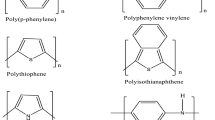Abstract
A series of ethylene propylene diene monomer (EPDM) nanocomposites have been prepared. First of all, EPDM is modified by grafting maleic anhydride to EPDM backbone. Subsequently, ethanolamine, 3-aminopropyltriethoxysilane and glycerine are added to react with the pendent anhydride to form grafted polyimides or polyols, respectively. The primary inorganic precursor, tetraethylsiloxane, is incorporated into these variously modified EPDM under acid condition to form the EPDM composites. The thermal properties of thermogravimetric analysis shows that the 20 % weight loss temperatures and char yields of various EPDM composites are higher than that of pristine EPDM. From the dynamic mechanic analysis studies, it exhibits both E′ and E″ of the composites are much higher than that of EPDM matrix. As confirmed by scanning electron microscopy, phase distributions of nano-inorganic component/SiO2 evenly disperse in these EPDM composites are correlated to exhibit higher rigidity and toughness than that of neat EPDM.









Similar content being viewed by others
References
Ismail H, Pasbakhsh P, Ahmad Fauzi MN, Abu Bakar A (2008) Morphological, thermal and tensile properties of halloysite nanotubes filled ethylene propylene diene monomer (EPDM) nanocomposites. Polym Test 27:841–850
Das A, De D, Naskar N, Debnath SC (2006) Effect of vulcanization technique on the physical properties of silica-filled EPDM rubber. J Appl Polym Sci 99:1132–1139
Davis SC, Fulton JB, Hoang PPM (1990) Chlorinated EPDM with superior stability. US Patent, US4959420 A
Makowski HS, Cain WP, Wei PE (1964) Readily curable chlorinated poly-α-olefins and ethylene-α-olefin copolymers indus. Eng Chem Prod Res Dev 3:282–291
Fu J, Wang L, Zhang A (2008) Toughening effect of EPDM-graft-methyl methacrylate and styrene (EPDM-g-MMA-St) on methyl methacrylate–styrene copolymer (MS resin). J Appl Polym Sci 108:3507–3515
Saikrasun S, Amornsakchai T (2012) Reinforcing performance of recycled PET microfibrils in comparison with liquid crystalline polymer for polypropylene based composite fibers. J Polym Res 19:9750–9843
Zhang J, Ding QJ, Hu BX, Liu BL, Shen J (2006) Novel preparation and properties of EPDM/montmorillonite nanocomposites. J Appl Polym Sci 101:1810–1815
Haitao S, Juqing C, Qiang Z, Wei Z, Qihui H, Baixing H, Jian S (2007) Preparation and properties of EPDM/TiO2 composites. J Appl Polym Sci 106:314–319
Kang D, Kim D, Yoon SH, Kim D, Barry C, Mead J (2007) Properties and dispersion of EPDM/modified-organoclay nanocomposites. Macromol Mater Eng 292:329–338
Yang H, Li B, Wang K, En Sun T, Wang X, Zhang Q, Fu Q, Dong X, Han CC (2008) Rheology and phase structure of PP/EPDM/SiO2 ternary composites. Eur Polym J 44:113–123
Ismail H, Mathialagan M (2012) Comparative study on the effect of partial replacement of silica or calcium carbonate by bentonite on the properties of EPDM composites. Polym Test 31:199–208
Mathialagan M, Ismail H (2012) Optimization and effect of 3-aminopropyltriethoxysilane content on the properties of bentonite-filled ethylene propylene diene monomer composites. Polym Compos 33:1993–2000
Zhang XF, Zhang Y, Peng ZL (2000) Dynamically vulcanized nitrile rubber/polyoxymethylene thermoplastic elastomers. J Appl Polym Sci 77:2641–2645
Pervorini TJ, Hertzberg RW, Manson JA (1990) Structure–property relations in an injection-moulded, rubber-toughened, semicrystalline polyoxymethylene. J Mater Sci 25:3385–3395
Prephet K, Horanont P (2000) Phase structure of ternary polypropylene/elastomer/filler composites: effect of elastomer polarity. Polymer 41:9283–9290
Nakanishi K, Solomon PH (1977) Infrared absorption spectroscopy. Holden-Day Inc., San Francisco
Chiang CL, Ma CCM (2004) Synthesis, characterization, thermal properties and flame retardance of novel phenolic resin/silica nanocomposites. Polym Degrad Stab 83:207–214
Fidalgo A, Nunes TG, Ilharco LM (2000) The structure of hybrid gels by drift and NMR spectroscopies. J Sol–Gel Sci Technol 19:403–407
Joseph R, Zhang S, Ford W (1996) Structure and dynamics of a colloidal silica-poly (methyl methacrylate) composite by 13C and 29Si MAS NMR spectroscopy. Macromolecules 29:1305–1312
Brinker CJ, Scherer GW (1990) The physics and chemistry of sol–gel processing. Sol–gel science. Academic Press, San Diego
Shih YF, Jeng RJ (2002) Carbon black containing IPNs based on unsaturated polyester/epoxy. I. Dynamic mechanical properties, thermal analysis, and morphology. J Appl Polym Sci 86:1904–1910
Wu CS, Liu YL, Hsu KL (2003) Maleimide–epoxy resins: preparation, thermal properties, and flame retardance. Polymer 44:565–573
Shih YF, Wang YT, Jeng RJ, Weic KM (2004) Expandable graphite systems for phosphorus-containing unsaturated polyesters. I. Enhanced thermal properties and flame retardancy. Polym Degrad Stab 86:339–348
Pearce EM, Leipins R (1975) Public health implications of components of plastics manufacture. Flame retardants. Environ Health Perspect 11:59–69
Acknowledgments
The authors thank the National Science Council of Taiwan for its financial support (NSC 99-2113-M-324-003-).
Author information
Authors and Affiliations
Corresponding author
Rights and permissions
About this article
Cite this article
Nien, YH., Yeh, PH., Shih, YF. et al. Modification of the structure of EPDM by chemically grafting inorganic species. J Sol-Gel Sci Technol 73, 350–357 (2015). https://doi.org/10.1007/s10971-014-3539-6
Received:
Accepted:
Published:
Issue Date:
DOI: https://doi.org/10.1007/s10971-014-3539-6




